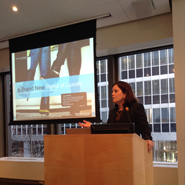- About
- Subscribe Now
- New York,
January 16, 2014

NEW YORK- Following the recession, luxury consumers became more focused on quality than quantity, said a senior executive at American Express Publishing at Luxury FirstLook: Strategy 2014.
American Express Publishing partnered with the Harrison Group on a study that surveyed American consumers with a household income of at least $125,000, and noticed that there has been a shift from extravagance to fear and anxiety, with luxury consumers being even more discerning in their shopping habits. In order to more effectively reach these consumers, luxury marketers have to understand the emotional state of this segment.
“We started to see in the research that there was this emotional recession starting to happen," said Cara David, senior vice president of corporate marketing and integrated media, American Express Publishing. "Seventy percent of our top five percent were telling us, 'I'm seriously concerned about this growing economic divide.'
"With extravagant spending, we started to see a pullback, they were telling us they wanted to be more stealthy," she said. "People were telling us how worried they were that they could run out of money.
"We saw this immediate change. People became more resourceful, they were telling us that they were looking at every single category to see how they could save.”
Luxury Daily organized Luxury FirstLook: Strategy 2014.
Consumer shift
American Express split the top 5 percent of luxury consumers into five groups based on their spending habits.
Two segments, the fabulists and the victors, are the traditional luxury consumers, buying across multiple brands and not at all interested in discounts. These consumers enjoyed their wealth, and wanted people to see how well they were doing through how much they accumulated.
The strivers and givers, in comparison, were less affluent, two-income households, and were more cautious with their spending, thinking over purchases before committing. The final group, the skeptics, did not want to be judged on their wealthy, and were not interested in acquiring material luxury goods.
From 2006 to 2009, the percentage of luxury consumers who fell into the fabulists and victors category has declined from 36 percent to 18 percent.
In 2008, there was a shift, and consumers began to become more resourceful and do research across product categories to see where they could save. From April 2010 to the first quarter of 2013, tablet ownership among luxury consumers rose from 0 to 70 percent, and wealthy individuals now use these devices to manage their finances, taking more control over their assets.
Affluent consumers are using tablets to manage their finances
With their changed fiscal mindset, the top 1 percent now saves 37 percent of their income, with the top 1 percent holding an average of $5,708,000 in savings and investments. This financial responsibility has lead to a rise in feelings of happiness, success and optimism for the future among the top earners.
In 2013, luxury consumers could be grouped into two categories based on purchasing mentality: deal dominant and worth dominant.
The deal dominant consumers are more independent in their shopping habits, always searching for the best price, and circumventing traditional vendors to find a value. Those that fall into the worth dominant are willing to pay more for quality merchandise, since luxury brands are a part of their lifestyle.
Respondents in both of these groups agree that they are now more resourceful and responsible, and across the board the majority of consumers have decided they can get better service from the Internet than a brand representative. Thirty-three percent of those surveyed say they rely less on sales staff or retail representatives now compared with five years ago.
Where these two segments differ is in the bottom line, where worth dominant individuals outspend deal dominant consumers, spending six times more on apparel and nine times more on handbags. The worth dominant group is also more likely to seek out new products and brands.
However, even though wealth dominant consumers are still seeking out products, the majority of luxury consumers rank goods low on the list of the top things they want. At the top of the list are quality time with family, travel and dining out, reflecting a changed attitude about what leads to fulfillment.
Luxury consumers are more focused on experiences, like travel
Reaching the target
In both groups, when choosing a luxury product, the majority responded that quality, materials and craftsmanship and service during the purchase process were always or almost always a necessity for true luxury.
The majority of worth dominant consumers rely on sales associates to explain why a specific product is worth more, with 56 percent of the group saying they have developed relationships with sales associates.
The wealthier an individual is, the more they rely on advertising to make purchasing decisions. Forty-four percent of worth dominant individuals rely on advertising in print magazines to help make purchase decisions.
To reach luxury consumers today, marketers have to communicate a consistent message across all channels that focuses on quality and service. Marketers should also foster a relationship, both through messaging and in-store, for instance with docents rather than sales associates.
To be effective, marketing messages should reflect the switch in attitude that luxury consumers have had over the past few years.
“At the end of the day, it's about a change in attitude to what makes a life well-lived," Ms. David said. "It's about the things that really matter, it's about connecting.
“True luxury supports the life they want to live," she said. "If you think about a high-quality life, which is what they tell us they want, they want luxury to be stress-free.
"Yes it’s a little bit about elegance, but it’s less about having to worry about the cost, being rare, being genuine, being unique. It’s more about the things that they feel inside that matter the most.”
Final Take
Sarah Jones, editorial assistant on Luxury Daily, New York
Share your thoughts. Click here